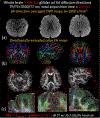High-fidelity, high-isotropic-resolution diffusion imaging through gSlider acquisition with and T1 corrections and integrated ΔB0 /Rx shim array
- PMID: 31373048
- PMCID: PMC6778699
- DOI: 10.1002/mrm.27899
High-fidelity, high-isotropic-resolution diffusion imaging through gSlider acquisition with and T1 corrections and integrated ΔB0 /Rx shim array
Abstract
Purpose: and T1 corrections and dynamic multicoil shimming approaches were proposed to improve the fidelity of high-isotropic-resolution generalized slice-dithered enhanced resolution (gSlider) diffusion imaging.
Methods: An extended reconstruction incorporating inhomogeneity and T1 recovery information was developed to mitigate slab-boundary artifacts in short-repetition time (TR) gSlider acquisitions. Slab-by-slab dynamic B0 shimming using a multicoil integrated ΔB0 /Rx shim array and high in-plane acceleration (Rinplane = 4) achieved with virtual-coil GRAPPA were also incorporated into a 1-mm isotropic resolution gSlider acquisition/reconstruction framework to achieve a significant reduction in geometric distortion compared to single-shot echo planar imaging (EPI).
Results: The slab-boundary artifacts were alleviated by the proposed and T1 corrections compared to the standard gSlider reconstruction pipeline for short-TR acquisitions. Dynamic shimming provided >50% reduction in geometric distortion compared to conventional global second-order shimming. One-millimeter isotropic resolution diffusion data show that the typically problematic temporal and frontal lobes of the brain can be imaged with high geometric fidelity using dynamic shimming.
Conclusions: The proposed and T1 corrections and local-field control substantially improved the fidelity of high-isotropic-resolution diffusion imaging, with reduced slab-boundary artifacts and geometric distortion compared to conventional gSlider acquisition and reconstruction. This enabled high-fidelity whole-brain 1-mm isotropic diffusion imaging with 64 diffusion directions in 20 min using a 3T clinical scanner.
Keywords: inhomogeneity; diffusion-weighted imaging; gSlider; shim array.
© 2019 International Society for Magnetic Resonance in Medicine.
Figures








Similar articles
-
Distortion-free, high-isotropic-resolution diffusion MRI with gSlider BUDA-EPI and multicoil dynamic B0 shimming.Magn Reson Med. 2021 Aug;86(2):791-803. doi: 10.1002/mrm.28748. Epub 2021 Mar 10. Magn Reson Med. 2021. PMID: 33748985 Free PMC article.
-
High-resolution in vivo diffusion imaging of the human brain with generalized slice dithered enhanced resolution: Simultaneous multislice (gSlider-SMS).Magn Reson Med. 2018 Jan;79(1):141-151. doi: 10.1002/mrm.26653. Epub 2017 Mar 5. Magn Reson Med. 2018. PMID: 28261904 Free PMC article.
-
Phase-matched virtual coil reconstruction for highly accelerated diffusion echo-planar imaging.Neuroimage. 2019 Jul 1;194:291-302. doi: 10.1016/j.neuroimage.2019.04.002. Epub 2019 Apr 3. Neuroimage. 2019. PMID: 30953837
-
Efficient T2 mapping with blip-up/down EPI and gSlider-SMS (T2 -BUDA-gSlider).Magn Reson Med. 2021 Oct;86(4):2064-2075. doi: 10.1002/mrm.28872. Epub 2021 May 28. Magn Reson Med. 2021. PMID: 34046924 Free PMC article.
-
In vivo B0 field shimming methods for MRI at 7T.Neuroimage. 2018 Mar;168:71-87. doi: 10.1016/j.neuroimage.2017.06.013. Epub 2017 Jun 7. Neuroimage. 2018. PMID: 28602943 Free PMC article. Review.
Cited by
-
SNR-enhanced diffusion MRI with structure-preserving low-rank denoising in reproducing kernel Hilbert spaces.Magn Reson Med. 2021 Sep;86(3):1614-1632. doi: 10.1002/mrm.28752. Epub 2021 Apr 8. Magn Reson Med. 2021. PMID: 33834546 Free PMC article.
-
Multishot Diffusion-Weighted MRI of the Breast With Multiplexed Sensitivity Encoding (MUSE) and Shot Locally Low-Rank (Shot-LLR) Reconstructions.J Magn Reson Imaging. 2021 Mar;53(3):807-817. doi: 10.1002/jmri.27383. Epub 2020 Oct 16. J Magn Reson Imaging. 2021. PMID: 33067849 Free PMC article.
-
dStripe: Slice artefact correction in diffusion MRI via constrained neural network.Med Image Anal. 2021 Dec;74:102255. doi: 10.1016/j.media.2021.102255. Epub 2021 Sep 25. Med Image Anal. 2021. PMID: 34634644 Free PMC article.
-
In vivo human whole-brain Connectom diffusion MRI dataset at 760 µm isotropic resolution.Sci Data. 2021 Apr 29;8(1):122. doi: 10.1038/s41597-021-00904-z. Sci Data. 2021. PMID: 33927203 Free PMC article.
-
Mapping the human connectome using diffusion MRI at 300 mT/m gradient strength: Methodological advances and scientific impact.Neuroimage. 2022 Jul 1;254:118958. doi: 10.1016/j.neuroimage.2022.118958. Epub 2022 Feb 23. Neuroimage. 2022. PMID: 35217204 Free PMC article. Review.
References
-
- Mansfield P Multi-planar image formation using NMR spin echoes. J. Phys. C Solid State Phys 1977;10:L55–L58 doi: 10.1088/0022-3719/10/3/004. - DOI
Publication types
MeSH terms
Grants and funding
- U01 EB025162/EB/NIBIB NIH HHS/United States
- R01 MH116173/MH/NIMH NIH HHS/United States
- R00 EB021349/EB/NIBIB NIH HHS/United States
- S10 RR019254/RR/NCRR NIH HHS/United States
- S10 RR019307/RR/NCRR NIH HHS/United States
- R01 EB020613/EB/NIBIB NIH HHS/United States
- S10 RR023043/RR/NCRR NIH HHS/United States
- U01 EB026996/EB/NIBIB NIH HHS/United States
- U24 EB028984/EB/NIBIB NIH HHS/United States
- K23 NS096056/NS/NINDS NIH HHS/United States
- R01 EB016695/EB/NIBIB NIH HHS/United States
- P41 EB015896/EB/NIBIB NIH HHS/United States
- S10 RR023401/RR/NCRR NIH HHS/United States
LinkOut - more resources
Full Text Sources

